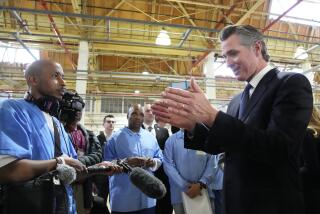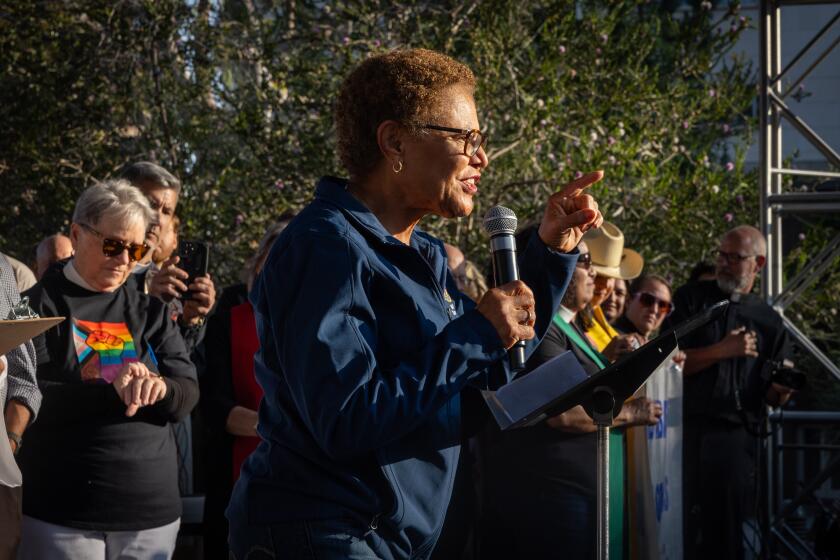CALIFORNIA ALBUM : Time Is Slow to Erase Stain of Grisly Killings : People in the Mother Lode town of Wilseyville would like to forget Charles Ng, Leonard Lake and a series of gruesome murders. But the outside world won’t let them.
- Share via
WILSEYVILLE, Calif. — In this piney Sierra foothills town, the talk is of the latest dusting of snow and, as always, the easy friendliness of the folks who live here, such as the postmaster, Dave Mitchell, who pays for the extra stamp when someone’s letter comes up short, knowing that the sender will pay him back.
It almost never turns to the gruesome murders committed a few miles from the Wilseyville store, post office and gas pump, out at the cabin that a bizarre survivalist named Leonard Lake once rented.
“People keep their comments to themselves,” said Shirley Brown, who owns the Wilseyville store with her husband, Fred. “They’re tired of it.”
“Just nobody’s business anymore,” Fred Brown said, unwilling to discuss it further.
But as if to remind any who would try to forget, another decomposed body was found at the cabin by its new owners in September--the body of a man who vanished 10 years before and who had been best man at Lake’s second wedding.
If that were not enough to keep the memories alive, there’s the matter of The People of the State of California vs. Charles Chitat Ng.
Ng, 32, Lake’s friend, faces charges of murder and conspiring with Lake to sadistically kill 12 people in 1984 and 1985. The ghoulish case made lurid headlines and shattered the serenity of this part of the Mother Lode back in 1985, when investigators unearthed 45 pounds of charred bone fragments and teeth--the remains of as many as 19 victims.
Over six months, police dug up jewelry, torn clothing, Lake’s rambling diary, a body in a sleeping bag and a videotape showing a man thought to be Ng tormenting two women victims. Police believe that Lake and Ng used a variety of stories to lure the victims, many of them from the Bay Area, and committed their crimes in a cramped cinder-block chamber that Lake had built.
The case ranks among California’s most infamous. Tabloid television shows feature it, a true crime book is in the works, and Ng’s mug appears on trading cards of serial killers.
*
For all the notoriety, Ng may not be tried here.
A defense team survey shows that an extraordinary 98% of people in Calaveras County are familiar with the case, and more than half believe Ng is guilty.
Almost everyone involved in the case assumes that the court will grant a change of venue to a good-sized town where, his lawyers hope, he can find an unbiased jury.
The cost of trying Ng would break this cow county, so the state is helping out. Deputy State Atty. Gen. Sharlene Honnaka is assisting the prosecutor, Calaveras County Dist. Atty. John Martin.
The case began serendipitously in June, 1985, when Ng and Lake were caught shoplifting a $75 vise at a building supply store outside South San Francisco. Ng fled, but Lake was arrested.
In Wilseyville, Lake went by the name Charles Gunnar. Gunnar had vanished in 1982. He was best man at Lake’s second wedding. It was his body that was found in September. Lake was known around the foothill towns as a man who attended Bible classes and held yard sales at the home he rented from his estranged second wife, Claralyn Balazs.
Lake had a history of mental instability, and was especially taken by John Fowles’ book, “The Collector,” about a psychopath who collects butterflies, then abducts a woman and treats her like one of his specimens. In the end, she dies.
In custody at the South San Francisco police station, Lake asked for a glass of water and a pencil. When police turned their backs, Lake scribbled a note to Balazs and other loved ones, took a cyanide pill and died.
A month later, in the Canadian city of Calgary, a security guard spotted Ng trying to shoplift a soda. Ng shot and wounded the guard but was wrestled into custody by the guard and a partner.
That began a six-year extradition fight.
Ng tried to persuade Canadian courts that under Canadian law, he could not be extradited because he would face the death penalty. In 1991, the Canadian Supreme Court voted 4 to 3 that Ng could be returned to California, regardless of the potential penalty. Within minutes, Ng was hustled under heavy guard onto a plane bound for California.
His trial will not begin for months, maybe not until next year. But until then, he continues to appear, shackled, in the Calaveras County Courthouse in San Andreas for pretrial motions--of which there are plenty.
A dishonorably discharged Marine, Ng often is described as a martial arts expert and self-styled Ninja. In a recent interview with the Sacramento Bee, the Hong Kong native charged that ethnic stereotyping has led to wildly exaggerated descriptions of his fighting ability.
“I’ve never used my martial arts on anyone, particularly on prison personnel,” he told the Bee. Ng also said he feels as if “everything is stacked against me--the opinion of the people, the witnesses.”
The sheriff concluded that the jail could not hold Ng, so he is being housed at the high-security state prison in Folsom outside Sacramento. One of Ng’s many court actions challenges the conditions of his confinement, arguing that he is being held in the highest security wing of the prison and is treated like a convicted murderer before his trial.
He complains that he must endure a 50-mile van ride from Folsom to San Andreas for his court appearances, and suffers from carsickness. The medication for it makes him so drowsy that it is hard for him to assist in his defense, the suit says.
He also decries the prison-issued lunches on court days. The sandwich bread one day was grease-soaked, the lunch meat desiccated and the cheese puffs soft, his federal suit says.
His most severe complaints are reserved for the “cage,” where he must spend court recesses. Built of iron and steel-mesh screen, the cage is 77 inches high, 33 inches wide and 50 inches long. The chair placed in it makes the cage so cramped that he cannot turn around.
Ng also has filed suit to remove his court-appointed attorneys, James Webster and Thomas Marovich of Sonora. He wants to be represented by a San Francisco public defender who is a death penalty defense specialist, and a private attorney from San Francisco.
Webster and Marovich succeeded in gaining the removal of Calaveras County’s one Superior Court judge, Orrin Airola, arguing that the jurist is biased in favor of the prosecution.
Airola’s roots in Calaveras County go back to 1860. His father was a Calaveras judge, and his sons are lawyers in town. Outside his courtroom, he said he could have fought the challenge but decided not to.
The county is changing, he said, and not all of it for the better. “At one time, we did have hardly any homicides,” he said. The county is still safe, which is why so many city folks are moving there. Too often, he said, “they bring their problems with them.”
Airola does not see much point in discussing Ng, especially with reporters. News accounts of the case do nothing more than pander to the “sadistic side” of human nature, he said.
In Wilseyville, where the post office doubles as the town message center, postmaster Mitchell, known as Mitch, can attest that the murders are rarely the topic of the day. When outsiders start asking about Ng, Mitch gets a little protective of his locals.
“It’s too nice a place to be maligned,” he said.
More to Read
Sign up for Essential California
The most important California stories and recommendations in your inbox every morning.
You may occasionally receive promotional content from the Los Angeles Times.













